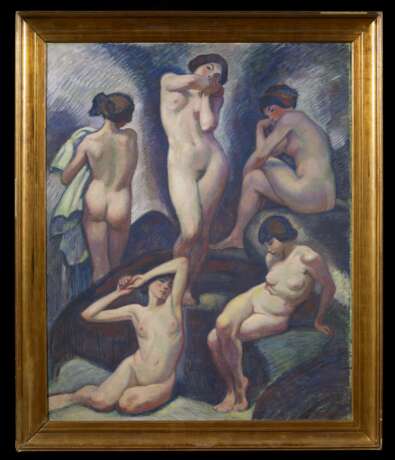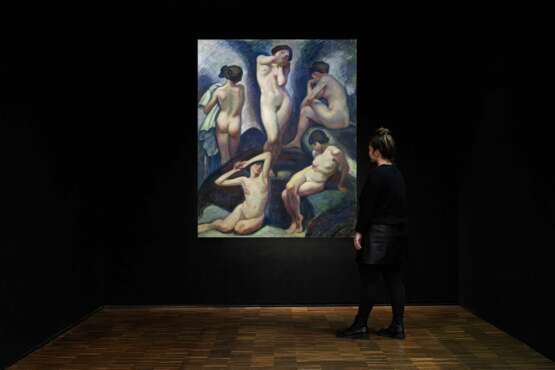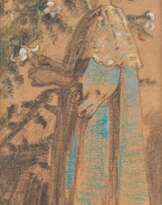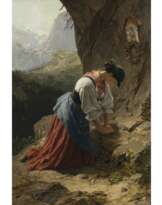ID 1072516
Lot 1343 | Ludwig von Hofmann. Five Acts
Estimate value
€ 30 000 – 40 000
Title: Five Acts.
Technique: Oil on canvas.
Measurement: 189 x 154cm.
Notation: Signed lower right: L.v. Hofmann.
Frame: Framed.
Verso:
On frame and stretcher frame Exhibition label: Galerie Cometer, Hamburg with no. N 768, Galerie Arnold, Dresden as well as Leipziger Kunstverein.
Exhibitions:
Exhibition of the Deutscher Künstlerbund 1913, Kunsthalle Mannheim 04.05.-30.09.1913, cat. no. 157, plate 18;
Special exhibition Ludwig von Hofmann in the context of the Hessian Art Exhibition Darmstadt 1917 (Consignor here was Galerie Ernst Arnold, Dresden.
Provenance:
Private ownership, Germany.
We are grateful to Annette Wagner-Wilke, Karben, for her kind assistance in cataloguing the present work.
In an exchange of letters with Gerhard Hauptmann dated 18.12.1913 Hauptmann praises the painting, here called ""Müde Stunde"" (Hesse-Frielinghaus (ed.): Briefwechsel LvH G. Hauptmann).
Ludwig von Hofmann was at the centre of the German art scene from the turn of the century until the 1920s; he celebrated great successes, had important collectors, was an influential teacher and a driving force in the avant-garde as well as in art politics. After the Second World War, he was forgotten by the general public. It was not until the 1990s that Ludwig von Hofmann was rediscovered by museums and collectors.
In turn-of-the-century Berlin, the centre of the German art world, Ludwig von Hofmann is a popular artist. His collectors include Karl von der Heydt, Empress Elisabeth of Austria and Hugo von Tschudi, who acquires five of his works for the National Gallery.
He creates numerous illustrations for the influential Art Nouveau newspaper "Pan".
Von Hofmann is a close friend of Gerhard Hauptmann and keeps company with Stefan George, Siegfried Wagner, Harry Graf Kessler and Henry van de Velde. An intensive collaboration began with the latter two when von Hofmann took up a professorship in Weimar in 1903. Here he became an important contributor to the "New Weimar" movement, which sought to give contemporary artists of all disciplines greater freedom. Von Hofmann moved to Dresden in 1916, where he became professor of monumental painting at the academy. In the 1920s and 1930s things became quieter for him. The National Socialists put some of his works on the list of the "degenerate", others continued to be exhibited.
Ludwig von Hofmann's works reveal the complexity of artistic expression around 1900: Art Nouveau and Symbolism, expressive physicality, the sigh of relief of the reform movement and the powerful new motifs of expressive dance, right up to neo-Saxon tendencies. Ludwig von Hofmann absorbed many currents with his painting and graphic art, always revolving around his central theme, the Arcadian harmonic life of man in nature.
The monumental painting presented here superficially allows us to participate in such an idyll: Five naked women in and in front of a rock formation. They are equally beautiful from all sides: slender, young, dark-haired. But there is no interaction between the figures. Each is introverted, resting in her pose. The academically exquisitely captured bodies contrast with the vibrating hatching of the rocks surrounding them. There is no sky, no water, no plants. The palette is limited to a little dark red, purples and blues in the rocks and the green underpainting of the incarnate. A great calm to melancholy emanates from the women, whose naked bodies convey nothing at all offensive. It is rather the awakening from a slumber, from a trance, that speaks from the calm of this painting
| Artist: | Ludwig von Hofmann (1861 - 1945) |
|---|---|
| Applied technique: | Oil |
| Auction house category: | Paintings 19th Century |
| Artist: | Ludwig von Hofmann (1861 - 1945) |
|---|---|
| Applied technique: | Oil |
| Auction house category: | Paintings 19th Century |
| Address of auction |
VAN HAM Kunstauktionen GmbH Hitzelerstr. 2 50968 Köln Germany | ||||||||||||||
|---|---|---|---|---|---|---|---|---|---|---|---|---|---|---|---|
| Preview |
| ||||||||||||||
| Phone | +49 221 92586215 | ||||||||||||||
| Fax | +49 221 92 58 62 4 | ||||||||||||||
| Buyer Premium | 32% | ||||||||||||||
| Conditions of purchase | Conditions of purchase | ||||||||||||||
| Business hours | Business hours
|














